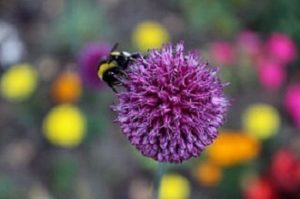
A new study carried out by researchers from Queen Mary University of London has demonstrated that bumblebees are much better at problem solving and capable of more complex learning than previously thought. The study also showed that bees can learn maneuvering a ball just by watching others carry out the task.
According to researchers, earlier studies with bumblebees have shown that it is possible to train these insects to pull strings and move levers to get rewards, and that bumblebees could learn by observing others doing it first.
“Previous [research] has found that bumblebees can do complex tasks but those tasks have always been really close to natural behavior,” said Olli Loukola, first author of the research from Queen Mary University of London.
According to Loukola, their team wanted to test the behavioral flexibility of these insects and see whether they could use a non-natural object in a task (likely never encountered before by these insects), for example, rolling balls.
In this study, researchers presented bees with a yellow ball, a platform, and a target area that contained concealed reservoir of sucrose. Researchers then used fake bee on a stick to repeatedly show the bees how to maneuver the ball over the target area to get sweet sucrose.
The team then tested abilities of bees, and found that 10 bees who were not shown a demonstration failed in the task. On the other hand, nine bees that were shown a demonstration successfully completed the task, and even improved their performance over test trials.
In second experiment, bees were presented with a platform having three balls at various distances from the center. Bees were divided in three groups, with each group receiving one of three different training scenarios. In first scenario, a trained bee moved the furthest ball to the center. In second scenario, a magnet was used to move the furthest ball to the center. In third scenario, no training was given to bees and just one ball was presented and placed in the center of the platform.
The team then tested the abilities of the bees to see if they could complete the task of moving one of three balls to the center to receive a drop of sugar solution.
The results obtained suggested that bees were on average more successful when trained by other bees than with the magnet. Bees that received no training had lowest success rate in the task.
Although bees were initially trained with a yellow ball, but when offered a choice of balls, many selected a ball, regardless of its color, that was nearest to the target.
“This means that the bees didn’t just simply copy the demonstrator and could improve upon the demonstrator’s technique or strategy,” said Loukola.
“The fact that they saw the task in different ways than the demonstrator shows a very impressive amount of cognitive flexibility.”
The detailed findings of the study have been published in journal Science.

